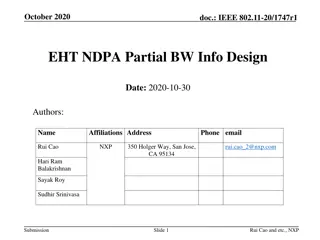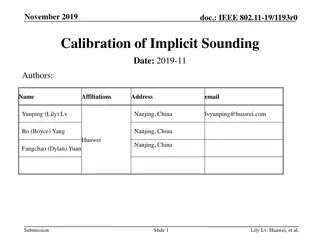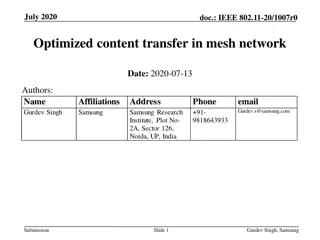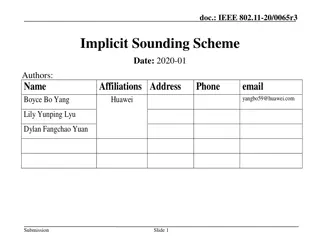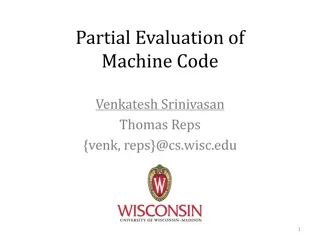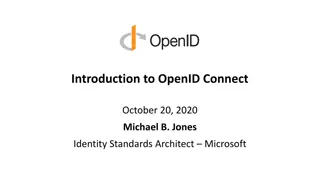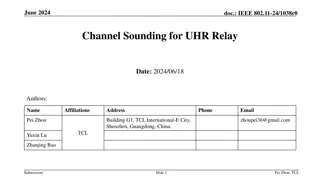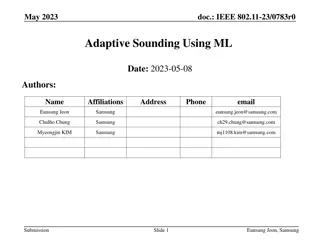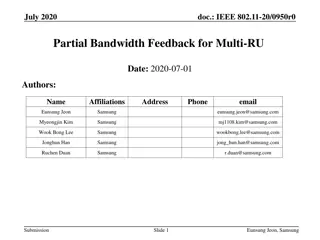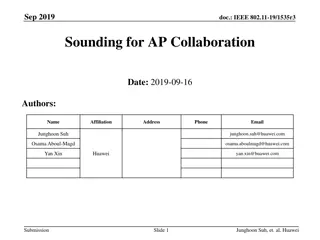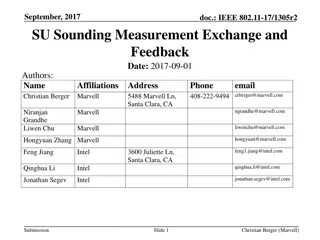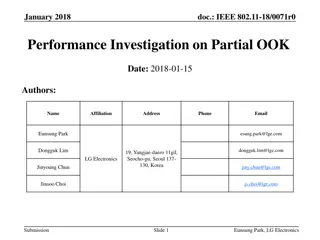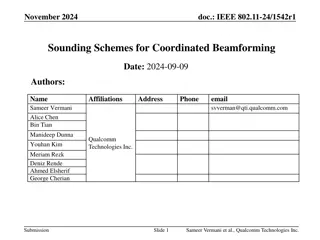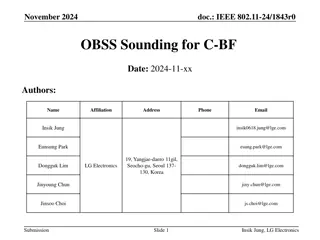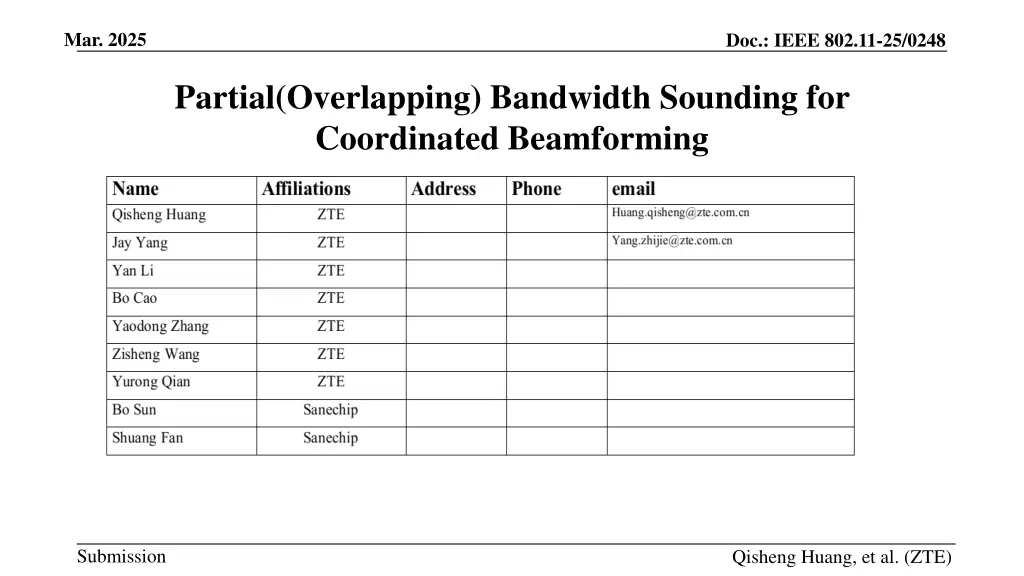
Efficient Coordinated Beamforming for IEEE 802.11 Networks
Explore a submission focusing on bandwidth sounding for coordinated beamforming in IEEE 802.11 networks, aiming to reduce feedback overhead and interference by addressing bandwidth mismatches and implementing pre-sounding frame exchange. The proposal suggests improvements in interference identification and feedback processes to enhance network performance.
Download Presentation

Please find below an Image/Link to download the presentation.
The content on the website is provided AS IS for your information and personal use only. It may not be sold, licensed, or shared on other websites without obtaining consent from the author. If you encounter any issues during the download, it is possible that the publisher has removed the file from their server.
You are allowed to download the files provided on this website for personal or commercial use, subject to the condition that they are used lawfully. All files are the property of their respective owners.
The content on the website is provided AS IS for your information and personal use only. It may not be sold, licensed, or shared on other websites without obtaining consent from the author.
E N D
Presentation Transcript
Mar. 2025 Doc.: IEEE 802.11-25/0248 Partial(Overlapping) Bandwidth Sounding for Coordinated Beamforming Submission Qisheng Huang, et al. (ZTE)
Mar. 2025 Doc.: IEEE 802.11-25/0248 Recap of 802.11bn Draft 0.1 Submission Slide 2 Qisheng Huang, et al. (ZTE)
Mar. 2025 Doc.: IEEE 802.11-25/0248 Observation on Bandwidth Mismatch Practical Bandwidth Mismatches: In real-world deployments, it is rare for APs and STAs to have exactly matching bandwidths. Cases where BW_AP1 BW_AP2 or BW_STA1 BW_STA2 are more common, making the current protocol inefficient for broader application. Lack of Protocol Design for Such Cases: The current protocol does not define a negotiation mechanism to form a beamforming group when bandwidth mismatches exist among APs and STAs. Seek for Reducing Feedback Overhead in UHR Sounding The feedback data volume for both STAs in Co-BF is large. However, since interference only occurs in the overlapping frequency bands, leveraging this fact can help reduce feedback overhead. Submission Slide 3 Qisheng Huang, et al. (ZTE)
Mar. 2025 Doc.: IEEE 802.11-25/0248 Consideration Main Purpose: Find a way to realize Co-BF with minimum feedback overhead Beamforming is at subcarrier level Beamforming is performed at the granularity of subcarriers The primary objective of coordinated beamforming is to mitigate interference between APs during simultaneous downlink transmissions. Interference Identification for Effective Beamforming To ensure the minimum required effectiveness of coordinated beamforming for interference suppression, it is sufficient to identify only the subcarriers where interference occurs. Reduced Feedback Overhead in Sounding Stage This approach significantly reduces the feedback overhead during the sounding phase by focusing only on the interfering subcarriers instead of the entire bandwidth. Submission Slide 4 Qisheng Huang, et al. (ZTE)
Mar. 2025 Doc.: IEEE 802.11-25/0248 Motivation Main idea: Pre-Sounding Frame Exchange for Overlapping Bandwidth: Before starting the Sounding measurement in Co-BF, control frame exchange process is utilized to identify the bandwidth where interference occurs. Might Co-BF Only on Overlapping Interfering Bandwidth: In the following Co-BF process, Co-BF is applied only to the overlapping bandwidth segments where interference is detected, improving efficiency and reducing computational overhead. Submission Slide 5 Qisheng Huang, et al. (ZTE)
Mar. 2025 Doc.: IEEE 802.11-25/0248 Partial(Overlapping) Bandwidth Sounding -1 Bandwidth Exchange and Sounding within a TXOP: Within a single TXOP during each sounding process, the initiating AP and cooperating AP exchange information about the sounding bandwidth . Subsequently, the measurement process for the overlapping bandwidth segments is announced and initiated using a trigger frame. BW Reporting Submission Slide 6 Qisheng Huang, et al. (ZTE)
Mar. 2025 Doc.: IEEE 802.11-25/0248 Partial(Overlapping) Bandwidth Sounding -2 Bandwidth Exchange and Channel Measurement in Multi-AP Initialization: During the initialization phase of a multi-AP beamforming group, the initiating AP and cooperating AP exchange information about the operating bandwidth . At the start of the UHR souding process, the initiating AP announces and triggers the measurement of the overlapping bandwidth segments using an NDPA frame. BW Reporting Submission Slide 7 Qisheng Huang, et al. (ZTE)
Mar. 2025 Doc.: IEEE 802.11-25/0248 Summary Considering the Practical Bandwidth Mismatches in deployment Therefore try to find a way to realize Co-BF at with minimum feedback overhead Before starting the Sounding measurement in Co-BF, an additional frame exchange process is introduced to identify the bandwidth where interference occurs. In the following Co-BF process, Co-BF is applied only to the overlapping bandwidth segments where interference is detected, improving efficiency and reducing computational overhead. Submission Slide 8 Qisheng Huang, et al. (ZTE)
Mar. 2025 Doc.: IEEE 802.11-25/0248 Staw Poll Do you agree to include overlapping bandwidth sounding for Co-BF in 11bn? The method to determine specific sounding bandwidth is TBD. Submission Slide 9 Qisheng Huang, et al. (ZTE)
Mar. 2025 Doc.: IEEE 802.11-25/0248 THANK YOU Submission Slide 10 Qisheng Huang, et al. (ZTE)
Mar. 2025 Doc.: IEEE 802.11-25/0248 Reference [1]802.11bn PAR Submission Slide 11 Qisheng Huang, et al. (ZTE)


